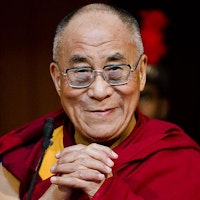The proper utilization of our intelligence and knowledge is to effect changes from within to develop a good heart.
The Dalai Lama

To Develop a Good Heart
Topic: Education & Character
“One problem with our current society is that we have an attitude towards education as if it is there to simply make you more clever, make you more ingenious. Sometimes it even seems as if those who are not highly educated, those who are less sophisticated in terms of their educational training, are more innocent and more honest. Even though our society does not emphasize this, the most important use of knowledge and education is to help us understand the importance of engaging in more wholesome actions and bringing about discipline within our minds. The proper utilization of our intelligence and knowledge is to effect changes from within to develop a good heart.“
Tenzin Gyatso, born on July 6, 1935, is known globally as the 14th Dalai Lama, the spiritual and former political leader of the Tibetan people. Born as Lhamo Thondup in a farming family in Taktser, Amdo, Tibet, he was recognized as the reincarnation of the 13th Dalai Lama, Thubten Gyatso, when he was just two years old. As the Dalai Lama, he holds the highest spiritual position within Tibetan Buddhism and is seen as a figure of great moral authority and influence. Following China's invasion of Tibet in 1950, he assumed full political power in 1950 but was forced into exile in India in 1959 after the failed Tibetan uprising against Chinese rule.
The Dalai Lama is renowned for his messages of peace, non-violence, inter-religious understanding, and compassion. He has authored numerous books and has lectured worldwide, becoming one of the most influential figures in the world of spirituality and philosophy. In recognition of his work for peace and non-violence, he was awarded the Nobel Peace Prize in 1989. Furthermore, his advocacy for the cultural and religious rights of the Tibetan people and his efforts to find a peaceful solution to the situation in Tibet through dialogue and understanding, rather than violence, have made him an internationally respected leader. Despite the political controversies and challenges, he remains committed to promoting human values and harmony among the world's religious traditions.
The Art of Happiness
The Dalai Lama , and Howard C. Cutler. The Art of Happiness. Riverhead Books, Penguin Putnam Inc., 1998, pp. 50-51 [Tenzin Gyatso, The Fourteenth Dalai Lama and Howard C. Cutler, The Art of Happiness].

The Dalai Lama
Copyright © 2017 – 2024 LuminaryQuotes.com About Us

The Art of Happiness
“The more sophisticated your level of education and knowledge about what leads to happiness and what causes suffering, the more effective you will be in achieving happiness. So, it is because of this that I think education and knowledge are crucial.”
–Tenzin Gyatso, The Fourteenth Dalai Lama and Howard C. Cutler [The Art of Happiness] pp.50-51.
Additional Dalai Lama Quotes
” If you think seriously about the true meaning of spiritual practices, it has to do with the development and training of your mental state, attitudes, and psychological and emotional state and well-being. You should not confine your understanding of spiritual practice to terms of some physical activities or verbal activities, like doing recitations of prayers and chanting…. If you understand spiritual practice in its true sense, then you can use all twenty-four hours of your day for your practice. True spirituality is a mental attitude that you can practice at any time. For example, if you find yourself in a situation in which you might be tempted to insult someone, then you immediately take precautions and restrain yourself from doing that…
This reminds me of one of the Tibetan Kadampa masters, Potowa, who said that for a meditator who has a certain degree of inner stability and realization, every event, every experience you are exposed to comes as a kind of teaching. It’s a learning experience. This I think is very true.”
–Tenzin Gyatso, The Fourteenth Dalai Lama and Howard C. Cutler [The Art of Happiness] p. 299.